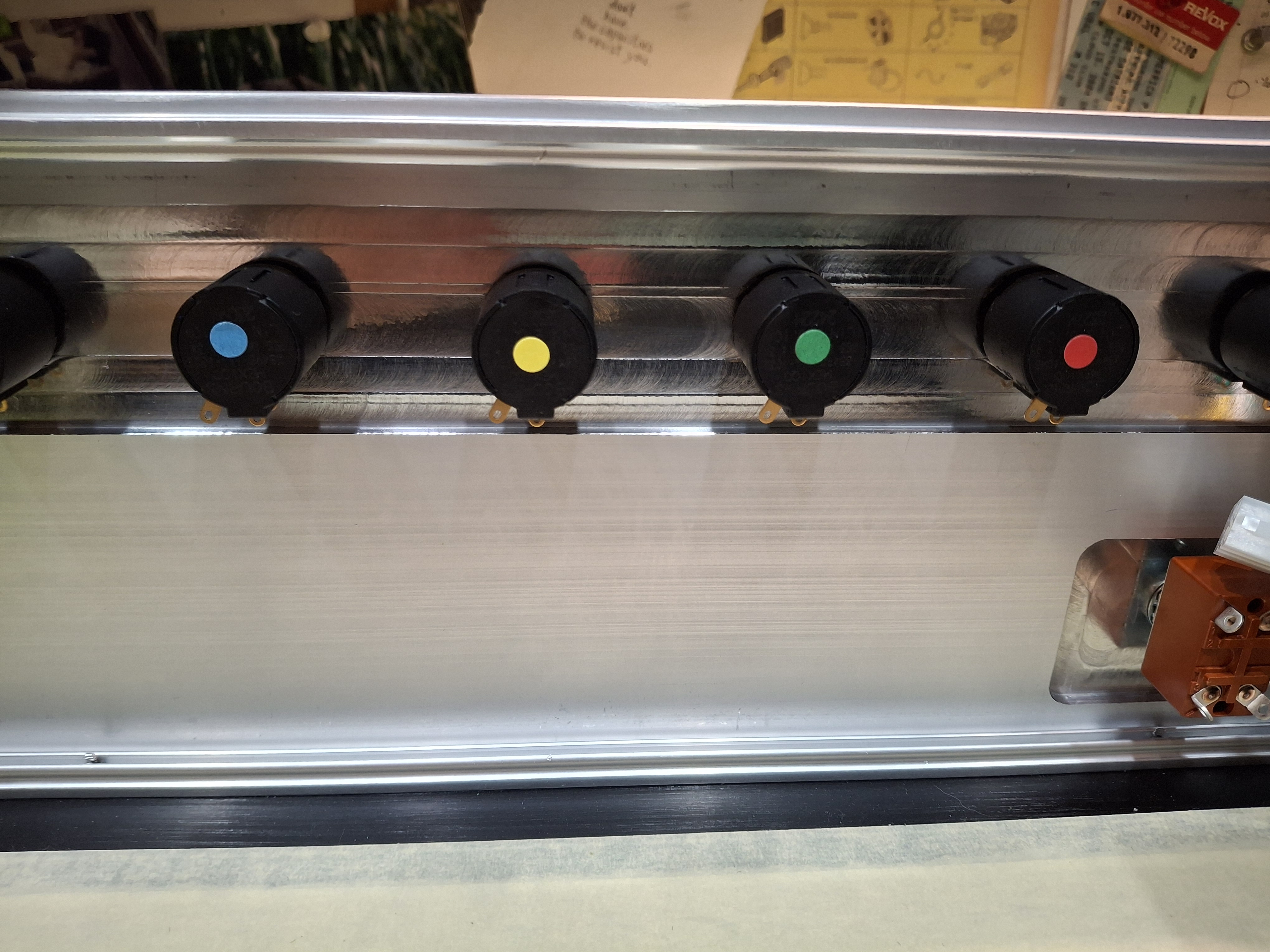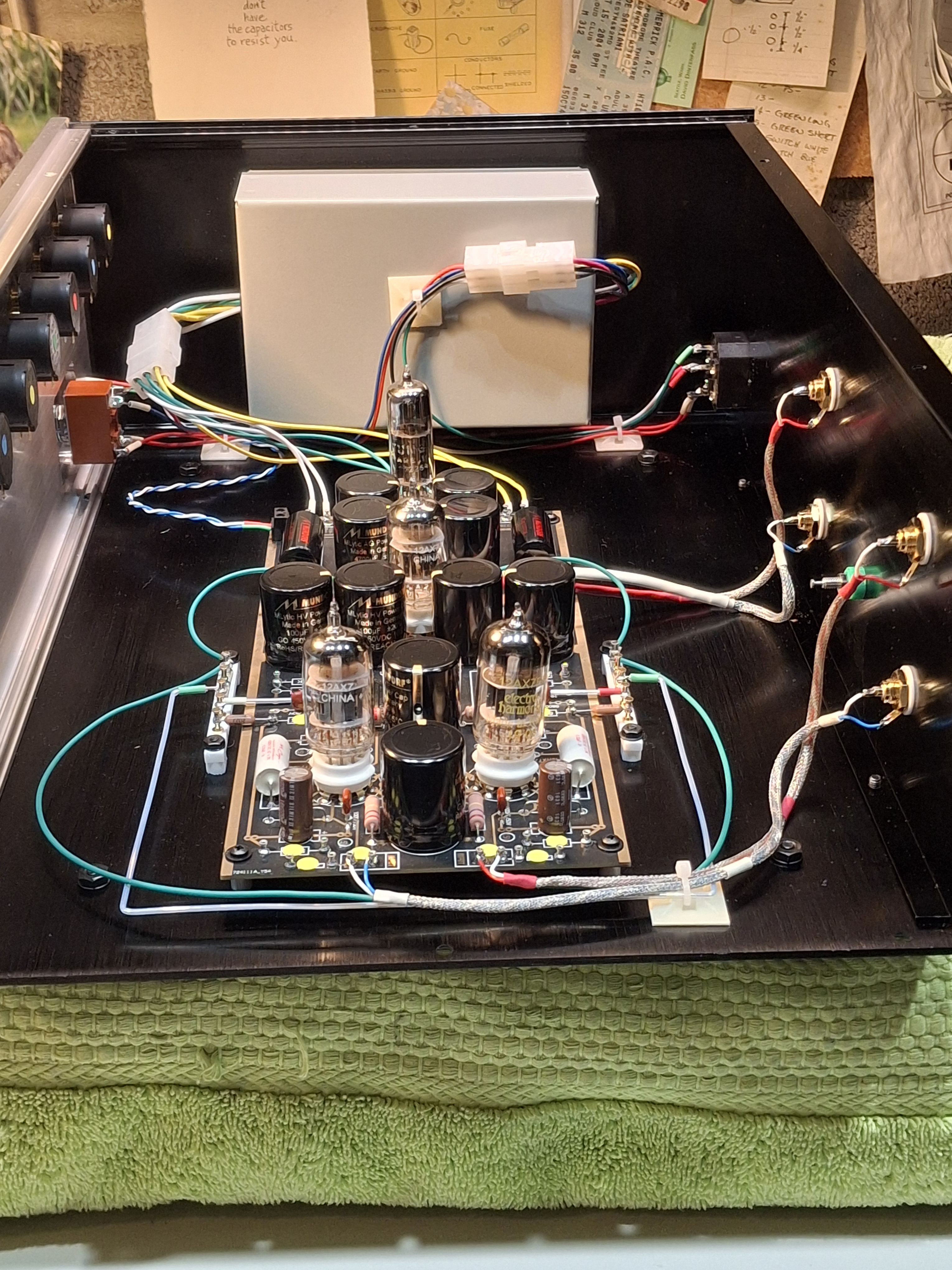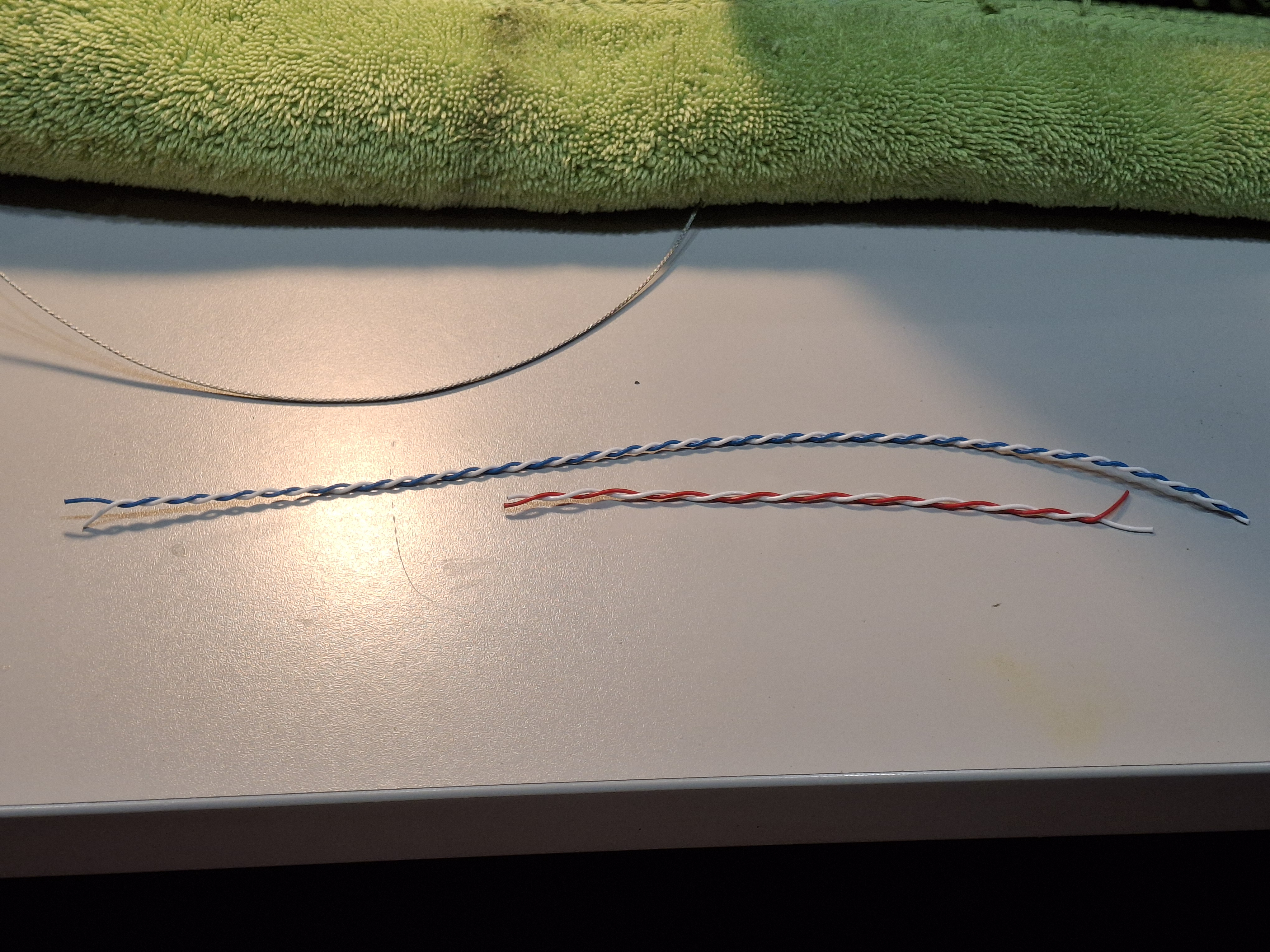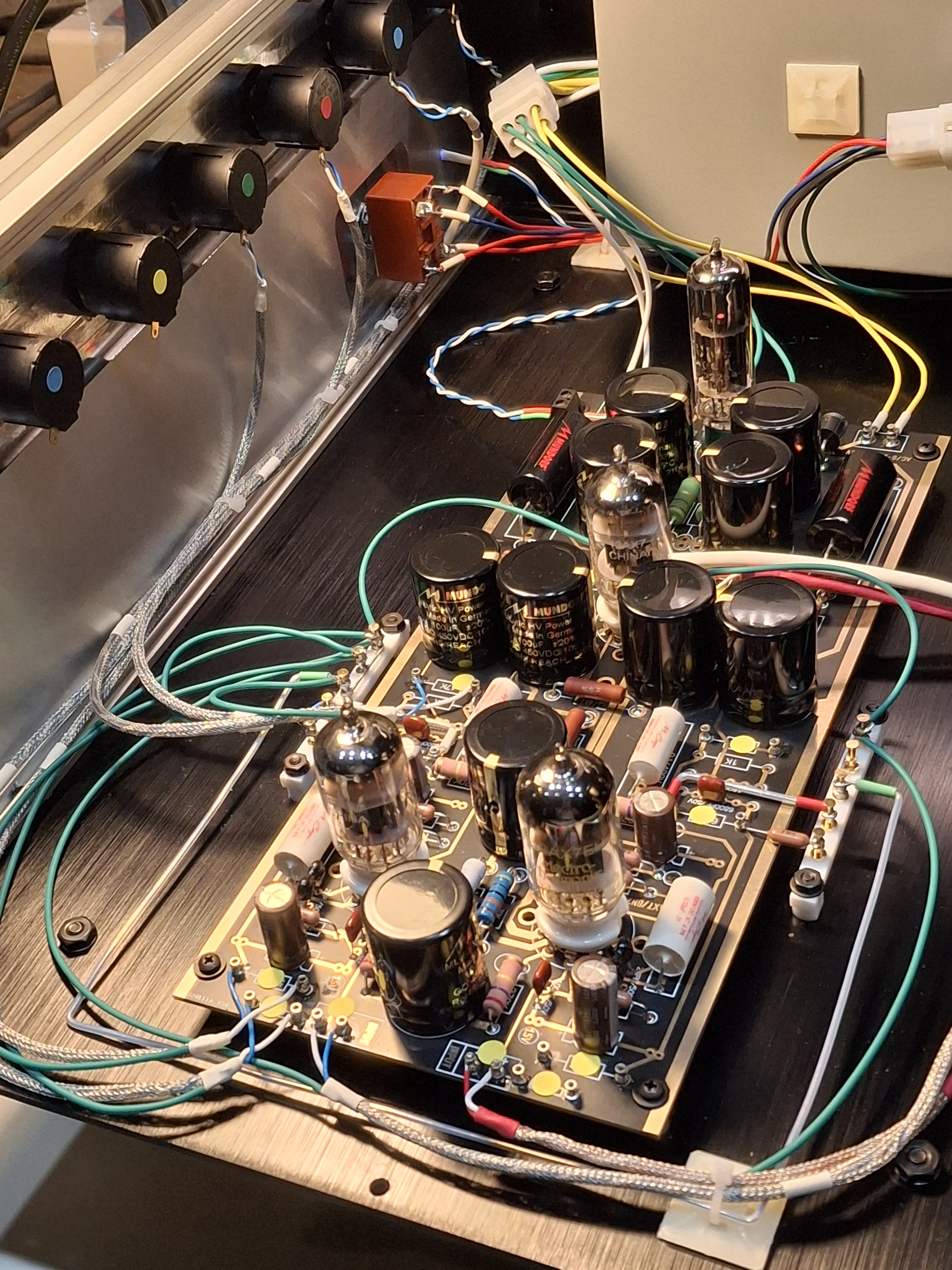Building a vacuum tube tape preamp

SeleniumFalcon
Posts: 4,280
Here are some photos of a tape playback preamp I'm building. It is based on the venerable Marantz 7 preamp with the playback EQ optimized for NAB tape. I plan on having quite a bit of adjustment, input loading, gain, bass EQ and high frequency EQ. The AC transformer is shielded in a steel box and the 8 potentiometers are multi-turn precision types from Bourns and all of the capacitors are from Mundorf and Elna.




Comments
-
-
-
Hey, how did you get one of my audiophile towels?
 Political Correctness'.........defined
Political Correctness'.........defined
"A doctrine fostered by a delusional, illogical minority and rabidly promoted by an unscrupulous mainstream media, which holds forth the proposition that it is entirely possible to pick up a t-u-r-d by the clean end."
President of Club Polk -
I got it from Muppet Labs, quantum green.

-
Nice project! Highest marks!
Are you going to add IEC capabilty? I noticed my Otari MX5050 has an IEC/NAB switch.
I have zero experience with IEC. I read that some claim less noise with IEC at 15ips. The other claim, NAB is said to be more analog sounding than IEC.Salk SoundScape 8's * Audio Research Reference 3 * Bottlehead Eros Phono * Park's Audio Budgie SUT * Krell KSA-250 * Harmonic Technology Pro 9+ * Signature Series Sonore Music Server w/Deux PS * Roon * Gustard R26 DAC / Singxer SU-6 DDC * Heavy Plinth Lenco L75 Idler Drive * AA MG-1 Linear Air Bearing Arm * AT33PTG/II & Denon 103R * Richard Gray 600S * NHT B-12d subs * GIK Acoustic Treatments * Sennheiser HD650 * -
There should be enough adjustment capability to accommodate both playback EQs. The two frequency curves are not too different. It mostly has to do with what happens during the recording end of the process, with IEC there's less high frequency manipulation needed and so that usually results in a better result. The majority of the high end prerecorded tape companies do IEC, but UltraAnalogue recommends NAB.
I think this preamp will do most of its duty with 7.5ips NAB playback, but that could change. I'm perfectly satisfied with the BAT preamp, it's just that I don't have the schematic for it (understandable from BAT's point of view) and the Marantz has been talked about and described thoroughly for many years. So I can learn from building one. -
I inherited an old Sony 500A from my dad's collection, which has an incorporated tube preamp. I've wondered if I could repurpose it, but perhaps it has an EQ built-in that is only meant for tapes.
This unit also a power amp and speakers, so kind of an all-in-one unit in a big suitcase. It's a beast.
Also have an Akai M-8, which has tubes as well, and is also a beast with a suitcase."This may not matter to you, but it does to me for various reasons, many of them illogical or irrational, but the vinyl hobby is not really logical or rational..." - member on Vinyl Engine
"Sometimes I do what I want to do. The rest of the time, I do what I have to." - Cicero, in Gladiator
Regarding collectibles: "It's not who gets it. It's who gets stuck with it." - Jimmy Fallon -
Interesting idea. About 5 years ago there was a discussion on HiFi Haven of using the Sony's output transformers in a power amplifier.
Have you played a tape on it? -
When I was triaging all my dad's gear a few years ago, I tried to play a tape on it. IIRC, it had some sort of issue with either FFWD or RWD, so I put a note on it, and set is aside. It's in a storage unit right now, along with lots of other gear. I should pull it out for more testing."This may not matter to you, but it does to me for various reasons, many of them illogical or irrational, but the vinyl hobby is not really logical or rational..." - member on Vinyl Engine
"Sometimes I do what I want to do. The rest of the time, I do what I have to." - Cicero, in Gladiator
Regarding collectibles: "It's not who gets it. It's who gets stuck with it." - Jimmy Fallon -
That sounds like a fantastic build! The Marantz 7 circuit is legendary for its warm and musical sound, and optimizing it for NAB tape playback is a great idea. The high-quality components—Bourns multi-turn pots, Mundorf and Elna caps, and the shielded AC transformer—should make for a very low-noise and highly adjustable preamp.
Are you planning to use tube or solid-state rectification? And will you have switchable EQ curves for different tape formats? -
Most of the time problems with older Sony decks are with jammed mechanical linkages due to hardened grease. In general terms they are incredible rugged and usually need a little maintenance to start working again.
-
Here is the schematic drawing:

It uses a vacuum tube based rectifier for the high voltage supply and a solid state rectifier for the filament supply. In all likelihood the adjustment capability will allow it to come close to meeting both NAB and IEC EQs. One of the more costly parts of this project will be selecting the knobs for the potentiometers, believe it or not. Depending upon which version I choose they can be over a $100.00 each and I need 8! There are the "high school gym locker" versions with a numbered dial up to really elaborate versions with numerical readouts. If I want to have a reference to be able to adjust from one setting to another I need to be careful which ones I pick.
I kind of want a Cello Palette look:
-

Maybe robots like audio gear too? -
For those, both biological and mechanical, who want to follow along let me elucidate the project. First let's look at the RIAA phono playback curve, shall we? Here is a graph depicting frequency across the bottom and response in dB on the vertical axis:

You can see it sort of looks like a ski slope. So at 50Hz it starts to drop off at 6dB per doubling of frequency. By the time you've reached 100Hz the output response has reduced by 6dB. At 200Hz the output is reduced another 6dB. But, instead of continuing this way until you've crashed into the ski lodge it starts to level off at 500Hz, giving you a chance to catch your breath. However, the fun begins again at 2,100Hz and things start falling again at the familiar 6dB per each doubling of frequency. There are other frequency changes some people have suggested, real flattening offs at high frequencies and real low filters to make record playing more fun. But, basically this is what happens to you whenever the needle hits your favorite record.
So, since everything sounds better with a name, the first roll off at 50Hz is called "pole 1", the level space is called "zero 1" and the second falling off is called "pole 2". The proposed second leveling is often called "zero 2".Post edited by SeleniumFalcon on -
Now that we've covered what needs to happen to the frequency response let's look at what Sid Smith and Saul Marantz came up with in their wonderful Marantz 7C ("C" stood for "cabinet" by the way). I'll re-post the schematic but with the parts labelled:

The overall circuit is pretty simple, a single 12AX7 is used for the first and second stage of amplification. Since the 12AX7 is really two tubes in the same glass bottle, one half does the initial gain, the output goes through C2 to the second half of the same tube. Then the output of this second half goes through another capacitor C6 and gets sent to the first grid of the second tube's first half and instead of its output coming from the plate it comes from the cathode. This is called a cathode follower, appropriate name.
But, now the fun begins. After the signal is retrieved and passes through C8 it starts a path back to the cathode of the first tube. Why do that? Well, remember the ski slope? We need to start shaping this poor audio signal so it can follow the curve we need. Components VR3 and C5 through their resistive and reactive efforts create our "pole 1" part of the slope. VR4 accomplishes the "zero 1" part of the needed shelf. The 1k resistor (unnamed in my drawing) and C9 create "pole 2" part of the response curve.
Now that we've cleared this up we can look at what the differences are between what happens in playing a record and that needed for playing tapes. -
Wow, quite an investment in knobs eh? Curious about the adjustment procedure.

The post for the RIAA curve reminded me of the older Scott gear I refurbed with the RIAA/NAB PEC module. The Teac 4000 preceded the 4010 and was just a transport with head out so you needed a receiver with NAB tape EQ and phono capability for the vinyl spinner.
These threads make me think about a Bottlehead Eros modded for NAB. IIRC The Eros uses a passive RIAA between the two gain stages. It punches way past its price point with premium tubes.

Salk SoundScape 8's * Audio Research Reference 3 * Bottlehead Eros Phono * Park's Audio Budgie SUT * Krell KSA-250 * Harmonic Technology Pro 9+ * Signature Series Sonore Music Server w/Deux PS * Roon * Gustard R26 DAC / Singxer SU-6 DDC * Heavy Plinth Lenco L75 Idler Drive * AA MG-1 Linear Air Bearing Arm * AT33PTG/II & Denon 103R * Richard Gray 600S * NHT B-12d subs * GIK Acoustic Treatments * Sennheiser HD650 * -
I may be wrong but I think the Bottlehead Eros conversion was the first mention of that approach. I really wish I had bought one of those when they were available. The BAT uses passive EQ while all the older designs, such as the M7, use negative feedback as far as I can tell.
That's a good assortment of knobs in the photo, especially the one in the upper right corner. -
A bit of progress. I mounted the AC transformer on the side panel using four 8-32 bolts with rubber insulated washers. Then I was able to install two Molex type connectors for connections to incoming AC and to the circuit board. Initially I thought I would use generic white coated wires for these, but after some thought I decided to go with the same color coded wires that came with the transformer. I found a source that had 25' quantities of all the colors I needed, now just have to wait.
The next step is to finalize the circuit board's position and a small terminal strip then mark the position on the bottom plate. I'm thinking about what feet to use now, just the basic set that came with the enclosure or go with something exotic?
-
This enclosure is really very versatile, all of the panels can be removed from the complete assembly. So I can take a side panel out and it gives me access to doing the wiring. With the AC transformer mounted to a side panel and the disconnect plugs I can easily remove it to get to the side of the circuit board. The front panel was actually too thick to be able to mount the potentiometers and the AC switch. I had to take it to a really good machine shop and he milled out the back to 1/2 the thickness. It also made mounting the front panel LED tricky, that and finding out LEDs come in oval shapes. It took four metric drill bits to get it right.

-
Some updates. We finally got our power back on after loosing it last Saturday night (hot showers are amazing!). Back down at the workbench and have installed the power supply connectors, verified the operating voltages are correct and installed the blue LED. Actually the LED was one of the more challenging aspects of this build so far. First of all, most LEDs tend to be oval in shape, which makes it difficult to drill a precise hole to fit them in. After ordering four gradually increasing metric drill bits I finally got a hole that has a smaller opening in the front with a slightly larger hole in the back to give a good fit.

-
The side of the enclosure with the transformer attached can be removed from the main chassis to allow access to solder connections.

-
Nice work on the LED and Molex connectors! I like the standoff terminal pins on the PCB too.
It reminds me of the two front chassis plates I had HiFi2000 machine in Italy. I had to fit an encoder with recess for knob, two LED's and an IR receiver with recess in rear of panel. I used Front Panel Express to design. That was a learning curve. LOL
Salk SoundScape 8's * Audio Research Reference 3 * Bottlehead Eros Phono * Park's Audio Budgie SUT * Krell KSA-250 * Harmonic Technology Pro 9+ * Signature Series Sonore Music Server w/Deux PS * Roon * Gustard R26 DAC / Singxer SU-6 DDC * Heavy Plinth Lenco L75 Idler Drive * AA MG-1 Linear Air Bearing Arm * AT33PTG/II & Denon 103R * Richard Gray 600S * NHT B-12d subs * GIK Acoustic Treatments * Sennheiser HD650 * -
I like the way you're implementing modularity in this build.
Let me guess. Might there be other interesting preamp boards you want to potentially compare?
Lovely, lovely work sir. -
Thanks for the kind words, guys, I appreciate your comments. On these projects I can get a bit swamped with thinking about everything that has to be done. So, Ive learned to concentrate on the small things and try and accomplish one thing at a time. Case in point, I don't like how the chassis fastening screws that attach the bottom to the front and back panels protrude about 1/16". I'd like to figure out what size they are and get some shorter versions.
There are some things I have been thinking about trying. When I first started this project I ordered a completed board that was already built for use as a phono preamp. The problem was the filter and coupling capacitors were seriously glued to the circuit board and wouldn't budge. So, I decided to get the board un-populated and pick the parts level myself. But, I still have the original board and it wouldn't be difficult to try it out. -
I've completed the wiring for the input and output connections and the shield grounding connections.

-
Each wire is made individually. I start off by using a low speed drill to twist two wires together. Then the twisted pair is inserted in a braided shield that I've soldered a drain wire. Then the ends are sealed in shrink tubing and installed.

-
I've finished wiring up the left channel from the four potentiometers to the corresponding terminals on the circuit board. The adjustments will allow for changes to the input loading, circuit gain, bass response and treble response. I connected a signal generator and meter and it seems to work, always a relief.

-
That's purdy. Beautiful work!➀Speakers: Polk1.2tl's (Uber Mods) ➁Pre/Amp/DAC: PS Audio BHK Signature & 250, DirectStream ➂Cables/IC's: MIT S1Bi-Wire/S1 Balanced +Avel Lindberg 1000VA "Dreadnought" ➃Power Conditioner: PS Audio P15 Power Plant ➄Power Cords: Core Power Technologies Gold, DH Labs Power Plus DIY w/Neotech NC-P301 & P311ends ➅Streaming: Roon ROCK on wifi'd NUC, TP-Link WAP, & Uptone EtherREGEN, AfterDark, Emperor Double Crown Clock, Black Modernize LPS, PS Audio AirLens⟿Ω☯☥☮⟿🔊♩♪♫♬♩♪♫♬♩♪♫♬
-
Thank you, I appreciate the comments. To illustrate my obsessive nature I got some 3.5mmx0.6mm 6mm screws for the bottom plate so they don't protrude up on the inside. I'll have to paint some black to match the others. Anybody have a good source for black paint?
-
Salk SoundScape 8's * Audio Research Reference 3 * Bottlehead Eros Phono * Park's Audio Budgie SUT * Krell KSA-250 * Harmonic Technology Pro 9+ * Signature Series Sonore Music Server w/Deux PS * Roon * Gustard R26 DAC / Singxer SU-6 DDC * Heavy Plinth Lenco L75 Idler Drive * AA MG-1 Linear Air Bearing Arm * AT33PTG/II & Denon 103R * Richard Gray 600S * NHT B-12d subs * GIK Acoustic Treatments * Sennheiser HD650 *






